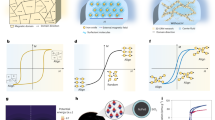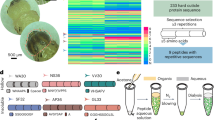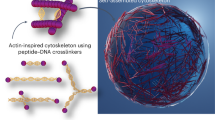Abstract
Self-propelled catalytic micro- and nanomotors have been the subject of intense study over the past few years, but it remains a continuing challenge to build in an effective speed-regulation mechanism. Movement of these motors is generally fully dependent on the concentration of accessible fuel, with propulsive movement only ceasing when the fuel consumption is complete. Here we report a demonstration of control over the movement of self-assembled stomatocyte nanomotors via a molecularly built, stimulus-responsive regulatory mechanism. A temperature-sensitive polymer brush is chemically grown onto the nanomotor, whereby the opening of the stomatocytes is enlarged or narrowed on temperature change, which thus controls the access of hydrogen peroxide fuel and, in turn, regulates movement. To the best of our knowledge, this represents the first nanosized chemically driven motor for which motion can be reversibly controlled by a thermally responsive valve/brake. We envision that such artificial responsive nanosystems could have potential applications in controllable cargo transportation.
This is a preview of subscription content, access via your institution
Access options
Subscribe to this journal
Receive 12 print issues and online access
$259.00 per year
only $21.58 per issue
Buy this article
- Purchase on Springer Link
- Instant access to full article PDF
Prices may be subject to local taxes which are calculated during checkout





Similar content being viewed by others
References
Sengupta, S. et al. Self-powered enzyme micropumps. Nat. Chem. 6, 415–422 (2014).
Li, J. et al. Nanomotor lithography. Nat. Commun. 5, 5026 (2014).
Wang, J. Nanomachines: Fundamentals and Applications (John Wiley & Sons, 2013).
Guix, M., Mayorga-Martinez, C. C. & Merkoci, A. Nano/micromotors in (bio)chemical science applications. Chem. Rev. 114, 6285–6322 (2014).
Wang, J. & Gao, W. Nano/microscale motors: biomedical opportunities and challenges. ACS Nano 6, 5745–5751 (2012).
Abdelmohsen, L. K. E. A., Peng, F., Tu, Y. & Wilson, D. A. Micro- and nano-motors for biomedical applications. J. Mater. Chem. B 2, 2395–2408 (2014).
Sengupta, S., Ibele, M. E. & Sen, A. Fantastic voyage: designing self-powered nanorobots. Angew. Chem. Int. Ed. 51, 8434–8445 (2012).
Peng, F., Tu, Y., van Hest, J. C. M. & Wilson, D. A. Self-guided supramolecular cargo-loaded nanomotors with chemotactic behavior towards cells. Angew. Chem. Int. Ed. 127, 11828–11831 (2015).
Tu, Y. et al. Mimicking the cell: bio-inspired functions of supramolecular assemblies. Chem. Rev. 116, 2023–2078 (2015).
Ismagilov, R. F., Schwartz, A., Bowden, N. & Whitesides, G. M. Autonomous movement and self-assembly. Angew. Chem. Int. Ed. 114, 674–676 (2002).
Mei, Y. et al. Versatile approach for integrative and functionalized tubes by strain engineering of nanomembranes on polymers. Adv. Mater. 20, 4085–4090 (2008).
Sánchez, S. et al. in Small-Scale Robotics. From Nano-to-Millimeter-Sized Robotic Systems and Applications (eds Paprotny, I. & Bergbreiter, S.) 16–27 (Springer, 2014).
Gao, W., Sattayasamitsathit, S., Orozco, J. & Wang, J. Highly efficient catalytic microengines: template electrosynthesis of polyaniline/platinum microtubes. J. Am. Chem. Soc. 133, 11862–11864 (2011).
Soler, L., Magdanz, V., Fomin, V. M., Sanchez, S. & Schmidt, O. G. Self-propelled micromotors for cleaning polluted water. ACS Nano 7, 9611–9620 (2013).
Zhang, L. et al. Controlled propulsion and cargo transport of rotating nickel nanowires near a patterned solid surface. ACS Nano 4, 6228–6234 (2010).
Gao, W., Sattayasamitsathit, S., Manesh, K. M., Weihs, D. & Wang, J. Magnetically powered flexible metal nanowire motors. J. Am. Chem. Soc. 132, 14403–14405 (2010).
Zhang, L. et al. Artificial bacterial flagella: fabrication and magnetic control. Appl. Phys. Lett. 94, 064107 (2009).
Zhang, L. et al. Characterizing the swimming properties of artificial bacterial flagella. Nano Lett. 9, 3663–3667 (2009).
Wang, W., Castro, L. A., Hoyos, M. & Mallouk, T. E. Autonomous motion of metallic microrods propelled by ultrasound. ACS Nano 6, 6122–6132 (2012).
Wang, W. et al. Acoustic propulsion of nanorod motors inside living cells. Angew. Chem. Int. Ed. 53, 3201–3204 (2014).
Paxton, W. F. et al. Catalytic nanomotors: autonomous movement of striped nanorods. J. Am. Chem. Soc. 126, 13424–13431 (2004).
Pavlick, R. A., Sengupta, S., McFadden, T., Zhang, H. & Sen, A. A polymerization-powered motor. Angew. Chem. Int. Ed. 123, 9546–9549 (2011).
Baraban, L. et al. Catalytic Janus motors on microfluidic chip: deterministic motion for targeted cargo delivery. ACS Nano 6, 3383–3389 (2012).
Ma, X. et al. Enzyme-powered hollow mesoporous Janus nanomotors. Nano Lett. 15, 7043–7050 (2015).
Wilson, D. A., Nolte, R. J. & van Hest, J. C. M. Autonomous movement of platinum-loaded stomatocytes. Nat. Chem. 4, 268–274 (2012).
Wu, Y., Wu, Z., Lin, X., He, Q. & Li, J. Autonomous movement of controllable assembled Janus capsule motors. ACS Nano 6, 10910–10916 (2012).
Abdelmohsen, L. K. et al. Dynamic loading and unloading of proteins in polymeric stomatocytes: formation of enzyme-loaded supramolecular nanomotor. ACS Nano 10, 2652–2660 (2016).
Kline, T. R., Paxton, W. F., Mallouk, T. E. & Sen, A. Catalytic nanomotors: remote-controlled autonomous movement of striped metallic nanorods. Angew. Chem. Int. Ed. 117, 754–756 (2005).
Ma, X., Hahn, K. & Sanchez, S. Catalytic mesoporous Janus nanomotors for active cargo delivery. J. Am. Chem. Soc. 137, 4976–4979 (2015).
Sanchez, S., Solovev, A. A., Mei, Y. & Schmidt, O. G. Dynamics of biocatalytic microengines mediated by variable friction control. J. Am. Chem. Soc. 132, 13144–13145 (2010).
Laocharoensuk, R., Burdick, J. & Wang, J. Carbon-nanotube-induced acceleration of catalytic nanomotors. ACS Nano 2, 1069–1075 (2008).
Baylis, J. R. et al. Self-propelled particles that transport cargo through flowing blood and halt hemorrhage. Sci. Adv. 1, e1500379 (2015).
Gao, W., Uygun, A. & Wang, J. Hydrogen-bubble-propelled zinc-based microrockets in strongly acidic media. J. Am. Chem. Soc. 134, 897–900 (2011).
Gao, W., Pei, A. & Wang, J. Water-driven micromotors. ACS Nano 6, 8432–8438 (2012).
Pantarotto, D., Browne, W. R. & Feringa, B. L. Autonomous propulsion of carbon nanotubes powered by a multienzyme ensemble. http:dx.doi/org/10.1039/b715310d (2008).
Tottori, S. et al. Magnetic helical micromachines: fabrication, controlled swimming, and cargo transport. Adv. Mater. 24, 811–816 (2012).
Sing, C. E., Schmid, L., Schneider, M. F., Franke, T. & Alexander-Katz, A. Controlled surface-induced flows from the motion of self-assembled colloidal walkers. Proc. Natl Acad. Sci. USA 107, 535–540 (2010).
Garcia-Gradilla, V. et al. Functionalized ultrasound-propelled magnetically guided nanomotors: toward practical biomedical applications. ACS Nano 7, 9232–9240 (2013).
Chang, S. T., Paunov, V. N., Petsev, D. N. & Velev, O. D. Remotely powered self-propelling particles and micropumps based on miniature diodes. Nat. Mater. 6, 235–240 (2007).
Loget, G. & Kuhn, A. Electric field-induced chemical locomotion of conducting objects. Nat. Commun. 2, 535 (2011).
Ibele, M., Mallouk, T. E. & Sen, A. Schooling behavior of light-powered autonomous micromotors in water. Angew. Chem. Int. Ed. 48, 3308–3312 (2009).
Ichimura, K., Oh, S.-K. & Nakagawa, M. Light-driven motion of liquids on a photoresponsive surface. Science 288, 1624–1626 (2000).
Hong, Y., Diaz, M., Córdova-Figueroa, U. M. & Sen, A. Light-driven titanium-dioxide-based reversible microfireworks and micromotor/micropump systems. Adv. Funct. Mater. 20, 1568–1576 (2010).
Magdanz, V., Sanchez, S. & Schmidt, O. G. Development of a sperm-flagella driven micro-bio-robot. Adv. Mater. 25, 6581–6588 (2013).
Mirkovic, T., Zacharia, N. S., Scholes, G. D. & Ozin, G. A. Fuel for thought: chemically powered nanomotors out-swim nature's flagellated bacteria. ACS Nano 4, 1782–1789 (2010).
Balasubramanian, S. et al. Thermal modulation of nanomotor movement. Small 5, 1569–1574 (2009).
Magdanz, V., Stoychev, G., Ionov, L., Sanchez, S. & Schmidt, O. Stimuli-responsive microjets with reconfigurable shape. Angew. Chem. Int. Ed. 53, 2673–2677 (2014).
Wu, Z. et al. Near-infrared light-triggered ‘on/off’ motion of polymer multilayer rockets. ACS Nano 8, 6097–6105 (2014).
Ma, X., Wang, X., Hahn, K. & Sánchez, S. Motion control of urea-powered biocompatible hollow microcapsules. ACS Nano 10, 3597–3605 (2016).
Li, Z., Barnes, J. C., Bosoy, A., Stoddart, J. F. & Zink, J. I. Mesoporous silica nanoparticles in biomedical applications. Chem. Soc. Rev. 41, 2590–2605 (2012).
Szatrowski, T. P. & Nathan, C. F. Production of large amounts of hydrogen peroxide by human tumor cells. Cancer Res. 51, 794–798 (1991).
Chen, T., Ferris, R., Zhang, J., Ducker, R. & Zauscher, S. Stimulus-responsive polymer brushes on surfaces: transduction mechanisms and applications. Prog. Polym. Sci. 35, 94–112 (2010).
Zhang, X. et al. Multifunctional up-converting nanocomposites with smart polymer brushes gated mesopores for cell imaging and thermo/pH dual-responsive drug controlled release. Adv. Funct. Mater. 23, 4067–4078 (2013).
Sui, X. et al. Stability and cell adhesion properties of poly(N-isopropylacrylamide) brushes with variable grafting densities. Aust. J. Chem. 64, 1261–1268 (2011).
Liu, H. et al. Dual-responsive surfaces modified with phenylboronic acid-containing polymer brush to reversibly capture and release cancer cells. J. Am. Chem. Soc. 135, 7603–7609 (2013).
Stuart, M. A. C. et al. Emerging applications of stimuli-responsive polymer materials. Nat. Mater. 9, 101–113 (2010).
Barbey, R. et al. Polymer brushes via surface-initiated controlled radical polymerization: synthesis, characterization, properties, and applications. Chem. Rev. 109, 5437–5527 (2009).
Schild, H. G. Poly(N-isopropylacrylamide): experiment, theory and application. Prog. Polym. Sci. 17, 163–249 (1992).
Shi, S. et al. Poly(N-isopropylacrylamide)–Au hybrid microgels: synthesis, characterization, thermally tunable optical and catalytic properties. Soft Matter 9, 10966–10970 (2013).
Howse, J. R. et al. Self-motile colloidal particles: from directed propulsion to random walk. Phys. Rev. Lett. 99, 048102 (2007).
Wilson, D. A., Nijs, B., Blaaderen, A., Nolte, R. J. & van Hest, J. C. M. Fuel concentration dependent movement of supramolecular catalytic nanomotors. Nanoscale 5, 1315–1318 (2013).
Wang, S. & Wu, N. Selecting the swimming mechanisms of colloidal particles: bubble propulsion versus self-diffusiophoresis. Langmuir 30, 3477–3486 (2014).
Acknowledgements
This work was supported by the European Research Council under the European Union's Seventh Framework Programme (FP7/2007-20012)/ERC-StG 307679 ‘StomaMotors’. We acknowledge support from the Ministry of Education, Culture and Science (Gravitation program 024.001.035). F.P. acknowledges funding from the China Scholarship Council. G.-J. Janssen and the General Instruments Department are acknowledged for providing support for the cryo-TEM and EDX measurements.
Author information
Authors and Affiliations
Contributions
Y. T. and D.A.W. conceived and designed the experiments. Y.T., F.P., X.S., Y.M. and P.B.W. performed the experiments. Y.T. analysed the data and prepared the manuscript. All authors discussed the results and contributed to the final form of the manuscript.
Corresponding author
Ethics declarations
Competing interests
The authors declare no competing financial interests.
Supplementary information
Supplementary information
Supplementary information (PDF 9982 kb)
Rights and permissions
About this article
Cite this article
Tu, Y., Peng, F., Sui, X. et al. Self-propelled supramolecular nanomotors with temperature-responsive speed regulation. Nature Chem 9, 480–486 (2017). https://doi.org/10.1038/nchem.2674
Received:
Accepted:
Published:
Issue Date:
DOI: https://doi.org/10.1038/nchem.2674
This article is cited by
-
Recent advances in small-scale hydrogel-based robots for adaptive biomedical applications
Nano Research (2024)
-
Adaptive insertion of a hydrophobic anchor into a poly(ethylene glycol) host for programmable surface functionalization
Nature Chemistry (2023)
-
Smart micro- and nanorobots for water purification
Nature Reviews Bioengineering (2023)
-
Fabrication of shape-tunable micromotors based on mass transfer and phase separation
Journal of Materials Science (2023)
-
Thermocatalytic hydrogen peroxide generation and environmental disinfection by Bi2Te3 nanoplates
Nature Communications (2021)



